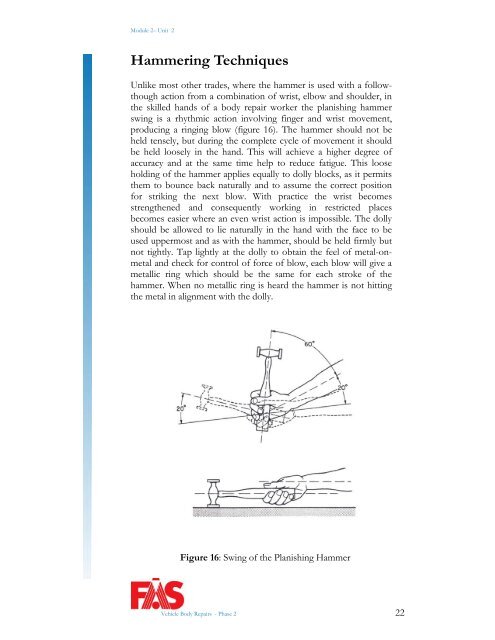TRADE OF VEHICLE BODY REPAIR - eCollege
TRADE OF VEHICLE BODY REPAIR - eCollege
TRADE OF VEHICLE BODY REPAIR - eCollege
You also want an ePaper? Increase the reach of your titles
YUMPU automatically turns print PDFs into web optimized ePapers that Google loves.
Module 2– Unit 2<br />
Hammering Techniques<br />
Unlike most other trades, where the hammer is used with a followthough<br />
action from a combination of wrist, elbow and shoulder, in<br />
the skilled hands of a body repair worker the planishing hammer<br />
swing is a rhythmic action involving finger and wrist movement,<br />
producing a ringing blow (figure 16). The hammer should not be<br />
held tensely, but during the complete cycle of movement it should<br />
be held loosely in the hand. This will achieve a higher degree of<br />
accuracy and at the same time help to reduce fatigue. This loose<br />
holding of the hammer applies equally to dolly blocks, as it permits<br />
them to bounce back naturally and to assume the correct position<br />
for striking the next blow. With practice the wrist becomes<br />
strengthened and consequently working in restricted places<br />
becomes easier where an even wrist action is impossible. The dolly<br />
should be allowed to lie naturally in the hand with the face to be<br />
used uppermost and as with the hammer, should be held firmly but<br />
not tightly. Tap lightly at the dolly to obtain the feel of metal-onmetal<br />
and check for control of force of blow, each blow will give a<br />
metallic ring which should be the same for each stroke of the<br />
hammer. When no metallic ring is heard the hammer is not hitting<br />
the metal in alignment with the dolly.<br />
Figure 16: Swing of the Planishing Hammer<br />
Vehicle Body Repairs - Phase 2 22
















